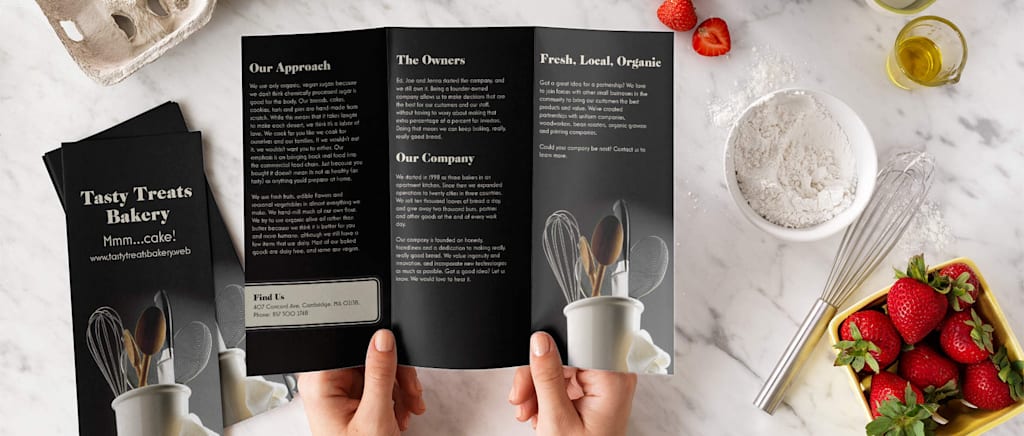In the world of marketing, understanding the different brochure ink types is crucial for creating a product that truly stands out. Whether you’re crafting glossy, colorful brochures for a new product launch or opting for sophisticated matte finishes, the choice of ink can significantly impact the result. In this article, we’ll explore the various brochure ink types available to marketers and how each type can affect the final presentation.

Understanding the Basics of Brochure Printing
Knowing the basics of brochure printing is the first step in selecting the right ink. Brochures are an essential tool for businesses to convey information effectively and attractively. The right ink choice enhances the visual appeal and clarity of the message. Discover more about crafting brochures from this resource on product brochures.
Types of Ink Used in Brochures
1. Digital Inks
Digital inks are widely used due to their versatility and ability to produce vibrant colors. Ideal for short-run printing, they offer quick turnaround times and are perfect for customized brochures where every copy is unique.
2. Offset Inks
Offset inks are known for their high-quality print results. They are best for long-run jobs, providing consistent quality and durability. Offset inks are also a cost-effective option when printing in bulk.
3. UV Inks
UV inks are cured using ultraviolet light, making them extremely durable and resistant to smudging. They are an excellent choice for brochures that will be handled frequently or displayed in direct sunlight.
The Impact of Finish on Brochure Inks
The finish of a brochure, whether it is glossy or matte, can greatly alter the perception of the ink’s color and clarity. For insights into glossy brochure options, visit glossy brochure printing.
Environmental Considerations
Choosing environmentally-friendly inks can reduce your carbon footprint. Soy-based and vegetable-based inks offer sustainable alternatives to traditional petroleum-based inks without compromising on quality.
Factors to Consider When Choosing Brochure Inks
1. Budget Constraints
Budget is often a significant factor. Digital printing is generally more economical for small quantities, whereas offset printing becomes more cost-effective at higher volumes. Consider your budget before making a decision.
2. Intended Use and Audience
The intended use of the brochure and its target audience should influence your ink selection. For high-end products, UV inks might be the way to go, while digital inks could suffice for informational pamphlets. Learn more about targeting the right audience with product launch brochures.
3. Color Requirements
If your brochure requires specific colors, understanding the difference between CMYK and Pantone inks is important. CMYK is standard for full-color printing, while Pantone inks offer precise color matching for brand consistency.
Technological Advancements in Brochure Printing
Advancements in printing technology continue to evolve, offering new opportunities for marketers. For the latest innovations in brochure printing, check out reliable brochure printing.
Longevity and Durability
Selecting the right ink also affects the longevity and durability of the brochure. For brochures that need to endure extensive handling or environmental factors, opting for more durable ink options is advisable.
The Role of Coatings
Coatings such as aqueous or laminate can protect the ink and enhance the brochure’s lifespan and appearance. These coatings can also add a tactile element, increasing the user’s engagement with the brochure.
Comparing Cost vs. Quality
Striking a balance between cost and quality is crucial. While cutting costs might seem appealing, investing in higher-quality inks often yields a better return on investment through an enhanced brand image and customer perception.
The Future of Brochure Inks
The future of brochure inks includes innovations such as biodegradable inks and nanotechnology. These advancements promise to provide more options for customization and sustainability to meet evolving marketing needs.
FAQ
What is the difference between digital and offset inks?
Digital inks are suitable for short runs and customizable options, while offset inks offer consistent quality for larger print runs.
Are UV inks suitable for all types of brochures?
UV inks are best for brochures that require high durability and exposure to sunlight, but their high quality makes them versatile for many types.
How can I ensure my brochure is environmentally friendly?
Consider using soy-based or vegetable-based inks and opt for recycled paper to minimize environmental impact.

Conclusion
Understanding the different brochure ink types is essential for marketers looking to produce high-quality prints. By considering factors such as budget, intended use, and technological advancements, you can make informed decisions that enhance the impact of your marketing materials. For a deeper dive into brochure creation, you may also explore this inspirational guide on MOO.
This article contains affiliate links. We may earn a commission at no extra cost to you.






